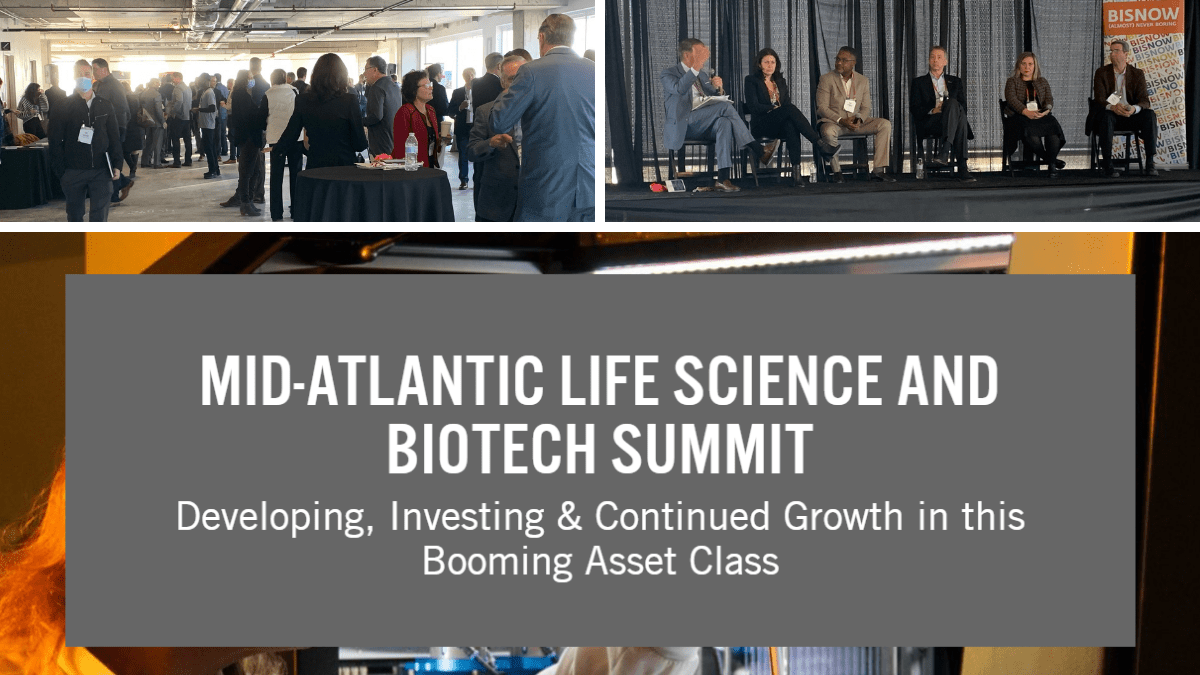
Nurturing the Growing BioHealth Capital Region Ecosystem – Reflections from the Mid-Atlantic Life Science and Biotech Summit
As I sit here on Day 614 of working from my home office, I can’t help but stare over at my sad, withering desk plants and think to myself how my dying succulents and wilting peace lily are, in a weird way, the perfect analogy for what we need to do to continue bolstering the life sciences ecosystem in the BioHealth Capital Region.
Stay with me here. You see, my issue with keeping houseplants is that I buy them and promptly place them on my desk. I immediately throw away the upkeep recommendations, disregarding any special individualized needs such as sunlight intensity or soil moisture, and instead give them all a squirt of water on occasion when they look a bit droopy.
Are my plants alive? Sure. But are they thriving? Absolutely not. Will they blossom flowers or sprout new leaves? Fat chance.
It’s no secret that the BioHealth Capital Region has blossomed into a competitive and notable life science ecosystem in recent years, with capital continuing to flow into the sector. We have much to celebrate in how far we’ve come, but we must also realize that the work is far from over. It’s not enough that our roots have been established – we need to think on how we can continue to support and nuture our ecosystem so that we can flourish.
Bisnow recently hosted two insightful panel discussions at its Mid-Atlantic Life Science and Biotech Summit earlier this month that talked about just that, featuring esteemed panelists from across the region. The event was held at Pike & Rose in North Bethesda, which itself will soon become a budding life sciences node in the BioHealth Capital Region with the addition of new built-for-purpose lab space.
Below are just a few of the key insights, reflections, and takeaways from the event.
The Importance of Infrastructure
Your office plant can’t (or at least, shouldn’t…) stay in the same pot forever – as it grows, it needs a bigger pot to thrive. So it goes with life science companies.
As more and more startups are born out of our neighboring universities, the demand for lab space has reached an all time high. And these companies unfortunately do not have the luxury of time or funding to wait 2+ years for space. In fact, even a year is often too long of a wait.
“As soon as the funds come in, biotechs start burning capital,” said Matt Brady, SVP at Scheer Partners. They need laboratory space ASAP, preferably in ~6 months.
There are a few different options for setting up new laboratory space to address demand, each with their set of pros and cons.
Speculatory (“Spec”) Space – These are smaller, more generic laboratories that are often built without established tenants. They are built to meet the basic needs that most startups require, meaning that entrepreneurs can move in and easier adapt, then move out as they start to grow and scale.
While these buildings can meet the demand of smaller companies, it’s inherently risky to develop spec space for companies who need specialized biomanufacturing needs. As Jason Rifkin, President at Equilibrium eloquently put it, “You can’t build a bottling plant with the hope that Coca-Cola happens to move in because they like your space. You need to build for their needs.” And with an increasing number of companies moving from R&D into the clinic and eyeing market approval, manufacturing needs are a consideration that can’t be ignored as we plan infrastructure.
Conversions – There’s a reason fixer-upper shows have become so popular in recent years – rather than building something new from the ground-up, why not convert the existing bones of a building into a lab space? With physical space often scarce, especially in urban areas, more and more firms are setting their sights on existing buildings. Everything from old city bus depots to former department stores are fair game.
The advantages here are that many of the basic necessities, such as electric, water, and sewage, are at least somewhat established in these spaces. While more work is needed to get utilities up to code for laboratory needs, builders need not start from scratch.
If you’re an avid fixer-upper show watcher, though, you know there is definite risk involved, with the unexpected often occurring once the walls are opened up. Despite this, conversions are still an attractive option for companies that are looking to occupy space fast.
Built-for-Purpose – These spaces are typically built from scratch, tailored specifically to the needs of the tenant that is looking to occupy. While these often take the longest to build, for those that require highly specialized space, such as cGMP or high level biosafety labs (BSL3 and BSL4), time might be a valid tradeoff if it means having a space that checks all of the boxes.
Panelists agreed that speed to occupancy was the key driver for clients. “As we look ahead to building new spaces, we need to be thinking in advance of what people need so that spaces require less retrofitting,” said Scott Nudelman, Founder at Glenline Investments.
And, as with any ecosystem, it’s important to remember that you’re not just operating in a bubble. Tina Patterson, Commissioner at the Montgomery Planning Board, noted that when you start a company, you become a part of that community and should embrace that accordingly. When residents see that a new lab space is being built, it’s not uncommon for them to have questions or express concern. How will this impact our environment? Will this raise housing prices? How will this affect local businesses?
“Community outreach is important because you’re not just dropping a building in a space – there’s a lot to consider before the construction even starts. Be transparent with your new neighbors about what’s going on, and make sure documentation is available. Show that you’re meeting all regulatory requirements,” said Tina.
The Workforce is Key
You can technically get away with just watering your office plants in most cases, but if you really want your plant to thrive, you need to use a good fertilizer. Similarly, a stellar workforce makes the difference between a “meh” market vs. an innovative market that is making an impact.
All panelists agreed that building the workforce at all levels, from seasoned executives to early career professionals, is critical to a thriving local life sciences sector. Talent is not always easy to come by, though, especially in this current market where the number of available jobs outpaces jobseekers.
And it’s not just about attracting and supporting the employees, but also the partners and collaborators in the surrounding ecosystem.
“Building networks and partnerships is crucial, especially with academics and hospitals, as they are housing your entrepreneurs and your clinical research partners,” said Matt Brady.
Scott Nudelman further noted that the BioHealth Capital Region should further build up and celebrate the stories of our local entrepreneurs so that more are encouraged to make the jump to the private sector, especially in a region where government jobs dominate.
And it’s not just about encouraging the next generation of entrepreneurs but nurturing those who have been here for some time. Companies that started on the I-270 corridor many years ago in R&D are now growing into manufacturing and have an array of different needs. If we can’t accommodate, then these companies will need to move elsewhere. We not only want companies to start here – we want to provide them the best resources so that they’ll stay here.
Ulyana Desiderio, Director of Life Sciences at the Maryland Department of Commerce, further stressed the importance of supporting individuals at all levels and stomping the perception that you can’t do biotech if you’re not a scientist. “Many think that you need an advanced science degree and a lab coat to have a successful career in biotech, and that’s just not the case,” she said. “There are many great training programs out there. Many of our community colleges are offering specialized biotech training programs and bootcamps that prepare you for these roles without having to go to a four-year university.”
“We need to talk to and work with our local companies to know what they need, and from there ensure that the workforce is ready,” said Ulyana.
“No matter who you are or where you come from, there are opportunities for you in this industry. And it’s not just about attracting that talent, but ensure those individuals have a path forward through mentorship, trainings, and other forms of professional development,” said Brad Stewart, SVP of Business Development at the Montgomery County Economic Development Corporation.
“High school graduates can get a biotech certification or participate in a biotech bootcamp program and enter a biomanufacturing career where they eventually make six figures,” said Peter Briskman, Executive Managing Director, Co-Lead at JLL Mid-Atlantic. He noted how this is somewhat of a well-kept secret that should be more common knowledge.
In growing the workforce, Ken Jenkins, Senior Advisor, Corporate Services at NFP, also noted the importance of tapping into different resources to find diverse talent. “Look at partnerships with community colleges and historically black institutions. When we make investments in these groups, we attract and retain diverse employees,” he said.
It’s also not just about supporting employees, but supporting the region as a whole. For example, how can you bring minority-owned companies, especially those that were hit hard by the pandemic, into your supplier chain.
And, unsurprisingly, infrastructure and workforce are tightly intertwined. “Companies must pay attention to housing rates. Employees generally want to have a shorter commute – someone who is paid $45K can’t live in an area where houses run for $1M,” said Tina.
Growing New Buds
If your office plant is thriving, it only makes sense to cut off a node and propagate it. Likewise, the BioHealth Capital Region is no longer limited to just those companies along I-270.
Life science hubs are popping up all over Maryland and Virginia, from Pike & Rose to Viva White Oak in Montgomery County to Richmond, Roanoke, and Norfolk in Virginia. And all have their own sets of characteristics and amenities.
“Areas like Baltimore-BWI are more suited to manufacturing and industrial needs, while Blacksburg and Charlottesville have Virginia Tech and the University of Virginia, which have more incubator space,” said Peter.
It’s not just about making satellite hubs, though. It’s imperative that we all collaborate and work together in service of one ecosystem.
“The RTP market has done a terrific job at surmounting distance. Duke University to NC State is the same distance as from Johns Hopkins to the University of Maryland in College Park, yet we often think of Johns Hopkins and UMD as separate entities,” said Brian Darmody, CEO at the Association of University Research Parks.
Panelists agreed that these regional silos should be broken down, and regional cooperation is key.
“Let’s celebrate each other and our successes – when one region wins, we all win,” said Amy Adams, Executive Director at the Institute for Biohealth Innovation at George Mason University.
The Year Ahead
In many aspects, 2021 was just, if not more challenging than its predecessor year. There have been a few silver linings, though, as we have all adapted to our new circumstances. The regional life science industry is no exception. While there are still many questions and uncertainties for what the next year will bring, panelists are hopeful for what lies ahead in 2022 and beyond.
“The pandemic has been extremely hard for all of us, but it’s opened up many opportunities for life science job growth. For my wish list, I really want to make sure that we’re continuing to provide the best training for our workforce so that all these jobs are accessible, from young adults right out of school to those looking to make a total career switch” said Ulyana.
“At Ellume, we’ve strived to be micro-focused and nimble. As telehealth and telecommunications become more engrained in our every day lives, we need to embrace change as we deliver healthcare solutions,” said Jeff Boyle, President of Ellume.
Celebrating wins and embracing change – together, we’ll keep forging ahead.
Here’s to a highly successful 2022 for the BioHealth Capital Region, as well as me developing a better green thumb in keeping my desk plants alive.

- About the Author
- Latest Posts
Sarah Ellinwood is BioBuzz’s Managing Editor. A scientist by training and a science communicator at heart, Sarah specializes in making complex concepts understandable, engaging, and exciting. She received her Ph.D. in molecular and cellular biology with a focus in infectious disease immunology from the University of Maryland and is passionate about all things related to scicomm, peer mentorship, and women in STEM.








